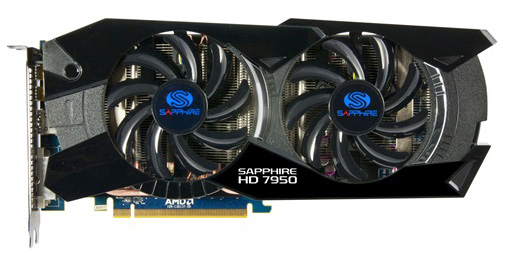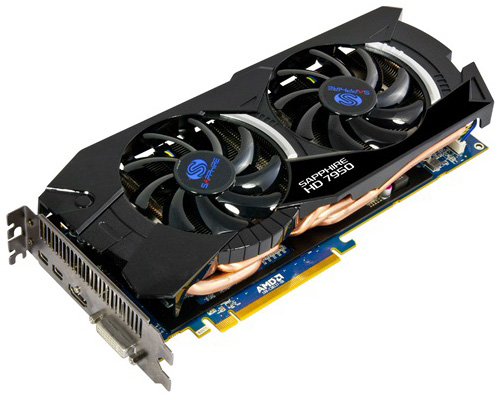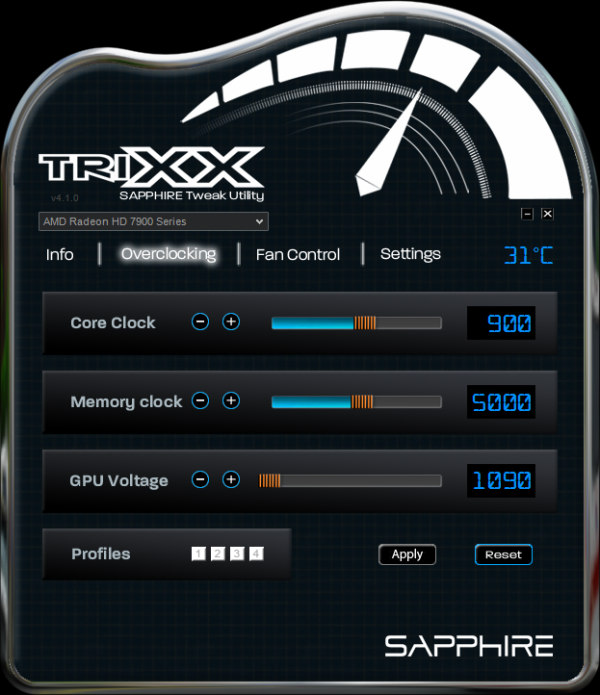AMD Radeon HD 7950 Review Feat. Sapphire & XFX: Sewing Up The High-End Market
by Ryan Smith on January 31, 2012 9:02 AM ESTMeet the Sapphire HD 7950 Overclock Edition
Since our reference 7950s are built on the 7970 PCB and cooler, we’re going to jump right into our vendor cards starting with the Sapphire HD 7950 Overclock Edition.
As with all of the 7950 cards launching today, Sapphire’s HD 7950 Overclock Edition uses the AMD 7950 PCB. This is a slightly shorter PCB measuring 10.25” long, saving .25” over the 7970 PCB by eliminating a few components that the lower board power of the 7950 makes unnecessary. The PCB is otherwise very similar to the 7970 PCB, utilizing 12 GDDR5 memory chips organized around the Tahiti GPU, while at the top you’ll find the 2 CrossFire connectors, a pair of 6pin PCIe power sockets, and the BIOS selection switch. The latter will be of particular interest to unlockers, as the switch should make it possible to safely attempt to unlock the 7950 into a 7970.

Moving on, as this is a semi-custom card the real differentiation is in the factory overclock and the cooler. On the performance side of things Sapphire will be shipping the 7950 Overclock Edition at 900MHz core and 5GHz memory, representing a 100MHz (12.5%) core overclock and no change on the memory clock.
Meanwhile for the cooler Sapphire is using what they’re calling the Dual-X cooler. The Dual-X is yet another double-wide dual-fan open air cooler, with 2 fans providing copious airflow over an aluminum heatsink running virtually the entire length of the card. Sapphire’s fan cutouts are just a bit bigger than most other dual-fan coolers and placed a bit higher, and as a result the Dual-X cooler is a bit taller than the PCB by about 15mm at its highest point. Meanwhile the cooler is also a fair bit longer than the PCB, putting the total card length at 11”.
Moving below the fans and the heatsink we’ll find the heatpipe assembly, which is responsible for carrying heat from the GPU to the heatsink. The Dual-X uses 5 copper heatpipes of varying radius that run from one end of the heatsink to the other. The 5 heatpipes converge at the base of the assembly, where a copper baseplate provides contact with the GPU. Meanwhile cooling for the VRM MOSFETs and RAM is provided by a black aluminum plate, which is placed over those components with heat transfer provided by the use of thermal pads. There is no connection between the plate and the heatsink, so the only heat dissipation from the plate is provided by whatever airflow from the fans reaches the plate.

At the front of the card we’ll find the display ports, which as this is an AMD PCB the card utilizes the standard AMD 7000 series port configuration of 1 DL-DVI port, 1 HDMI port, and 2 mini-DisplayPorts. Filling out the second slot is the grating for ventilation, though even with the ventilation slot the usual precautions for an open-air cooler apply: you’ll need a case with enough airflow to handle the roughly 200W of heat the card is capable of dumping inside of your case.
Rounding out the package is the usual collection of dongles and materials. Sapphire includes 2 molex-to-6pin PCIe adaptors, an HDMI to DVI dongle, a miniDP to DisplayPort dongle, a DVI to VGA dongle, and a 1.8m HDMI cable. Along with the dongles Sapphire packs a quick start guide and a driver installation CD.
The only thing you won’t find packed in the box is TriXX, Sapphire’s in-house overclocking utility. TriXX has been around since the 6900 series, but as this is the first high-end Sapphire card we’ve reviewed since it was released, this is the first time we’ve had it available for a review.
Fundamentally TriXX is a fairly well designed, albeit barebones overclocking utility. Along with an info readout similar to GPU-Z, TriXX provides overclocking and fan control support for Sapphire’s cards, including support for custom fan profiles and more importantly voltage control. With TriXX it’s possible to overvolt most of Sapphire’s performance and high-end cards, and as Sapphire uses AMD reference PCBs it also works with any other cards using AMD’s PCBs.
Beyond these features there’s little more to TriXX. It’s not an all-encompassing video card utility like MSI’s Afterburner, which means it comes up short if you need more functionality but it's exactly what you need if you just want to overclock. To that end it’s a clear step up compared to most other manufacturer’s poorly designed utilities, and from a design perspective its only real sin is the hard to read blue-on-black text. Otherwise it’s a competent overclocking utility that does exactly what it’s supposed to and provides voltage control for those who need it.
Finally, Sapphire will be selling the 7950 OE for $479, $30 over the baseline 7950 MSRP. Meanwhile the warranty on their card is their standard 2 year warranty.















259 Comments
View All Comments
MrBungle123 - Tuesday, January 31, 2012 - link
I don't think Anandtech is read by the "average user"... I would assume mostly gamers, enthusiasts, and IT pros here. Besides who buys 1920x1080 monitors? If the monitor isn't 1920x1200 or higher its not worth buying.Ryan Smith - Tuesday, January 31, 2012 - link
Hi poohbear;When drawing out the tests for the current GPU benchmark suite we debated between 1920x1200 and 1920x1080. Ultimately it was decided that 1920x1200 would be more useful for our needs and that 1920x1080 would be unnecessary; 1920x1080 is only slightly lower in resolution, so our 1920x1200 numbers are only slightly worse in performance than they would be with 1920x1080. The two should be treated as the same, as there's generally not nearly enough of a difference to matter.
-Thanks
Ryan Smith
Pantsu - Tuesday, January 31, 2012 - link
It seems there's two choices for 7950, either a 450€+ custom OC card or a "v2" reference cheapo-PCB cards that go for 400€ in Europe. It would certainly be interesting to get a detailed look at how much of a difference that makes. To me those "v2" cards look a bit too nerfed in terms of VRM and cooling.IMO 7950 is priced accordingly and is no question better than a GTX 580 by any metric really. That's enough to justify a similar price. It's up to Nvidia to drop the GTX 580 price to compete, but I doubt they'll do that, and instead wait for GK104 to save the day. If it is a success we could see prices drop fast in the high end, but Nvidia isn't known for its low pricing, and neither does it have any need to try grab market share by undercutting its profits. There's a good cap between 7800 and 7900 and they could just occupy it with a GK104 and call it a day, until they get their big chip ready.
marc1000 - Tuesday, January 31, 2012 - link
Any word on 7870 from amd?UMADBRO - Tuesday, January 31, 2012 - link
Feb 15marc1000 - Tuesday, January 31, 2012 - link
Ty!just4U - Tuesday, January 31, 2012 - link
That Sapphire cooler looks pretty much like their Dirt3 Edition 6950s one. A slightly different plastic shroud but fan's and underlay seem mostly the same.. atleast in the picture views I've seen.gamoniac - Tuesday, January 31, 2012 - link
I found that, in IE 9, I have to click on the "Back" button on the browser six to seven times to actually go back to the main page. Taking a closer look at it, I noticed there are a bunch of "Share this Page" history item between this page (Ryan's HD7950 Review) and the main page that took place without my knowledge. Would this be a site bug or a advertisement bug?Ryan Smith - Tuesday, January 31, 2012 - link
To the best of my knowledge (please keep in mind that I'm not responsible for site development), that's not something the site should be doing. In which case it could very well be an ad bug. If it continues to happen you should be able to use the IE9 developer tools (built-in, F12), to try to narrow down what exactly it is you're seeing.gamoniac - Tuesday, January 31, 2012 - link
Without spending too much time on it, I can see that there were a bunch of frame navigation caused by sharethis.com, which I think is the likely culprit. I am able to reproduce this issue on two separate Win7 SP1 machines; one of them is clean with almost installed except for the usual PDF reader and some benchmarking tools.Check out these three images I uploaded:
In the beginning:
http://i43.tinypic.com/nqwgti.jpg
Problem captured:
http://i44.tinypic.com/jai5gk.jpg
IE9 F12 screen shot showing frame navigation:
http://i44.tinypic.com/14y226q.jpg
Good luck.